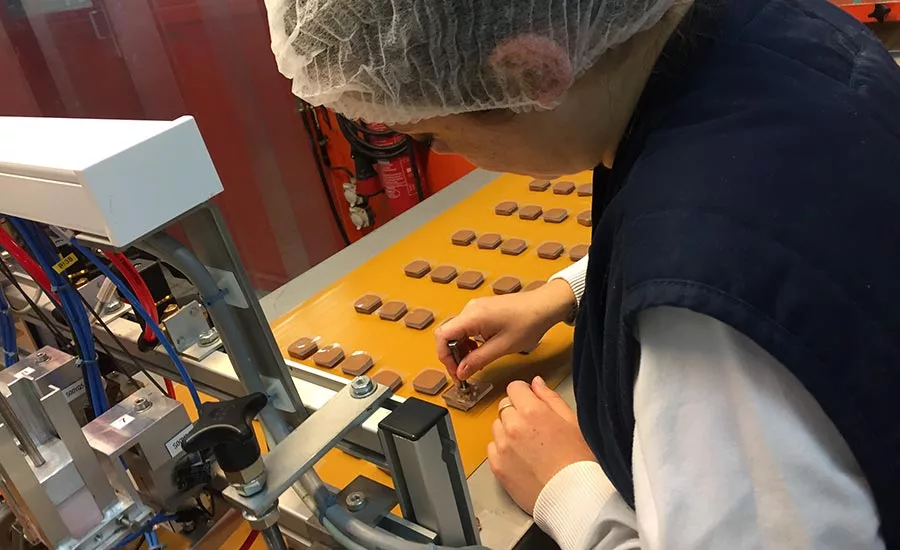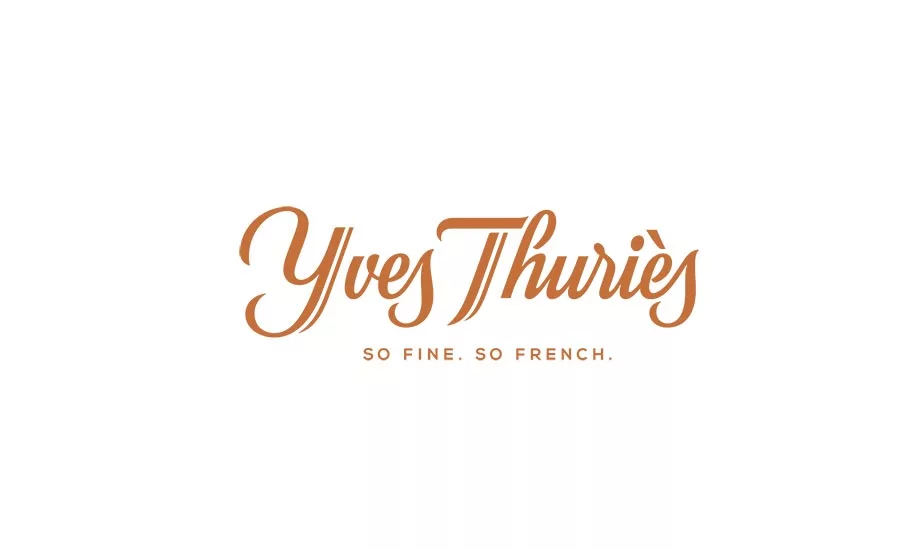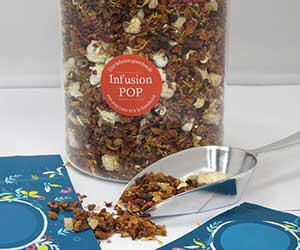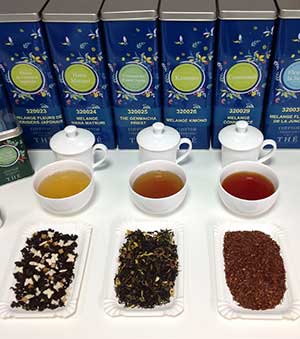Fabulous Food Plant
Salpa: The French company combining innovation and craftsmanship
A look into how the French company uses quality ingredients and precision to manufacture specialty products.

Chocolates are coated with marble coloring in the company’s turbines.



Yves Thuriès is launching new flavors of its bars to appeal to U.S. consumers, including dulce, matcha, peppermint, banana and mango.


The Yves Thuriès logo has been updated to be simpler and ideally more appealing to consumers in the United States.
There’s something about France and all the food there that’s as intoxicating as any wine. It’s easy to see how Julia Child could have fallen so passionately in love with the country’s cuisine. From the decadent escargot drenched in butter sauce to the fresh baguettes served at street stands, the French know their food.
And it turns out that passion and expertise apply to chocolates too—at least when it comes to the French chocolate company Salpa. Food Engineering recently was invited to visit Salpa’s factories in France, including its two chocolate factories, as well as its tea factory (see sidebar).
Article Index:
- Schaal features Yves Thuriès macarons, shapes chocolates
- The Excellence factory producing hand-decorated creations and chocolate bars
- Sidebar: Salpa’s teas meet international standards
The company, which makes chocolate, coffee and tea under nine different brands, sells its chocolate under the Yves Thuriès brand in the United States, named after Yves Thuriès, a well-known pastry chef who has twice been named “Best Craftsman” in France.
Salpa is run by its President Jean-Paul Burrus, who represents the third-generation working in the confectionery business. Salpa has two chocolate factories, “Schaal” located in Strasbourg and considered as the main chocolate factory and “Excellence” located in the south of France that focuses more on artisan creations and chocolate bars.
The Burrus family has been working in the chocolate business since 1912, acquiring chocolate brands Yves Thuriès, Schaal, Côte de France and Marquise de Sevigne. Jean-Paul Burrus extended the product range, acquiring Coffea, which specializes in coffee, and creating the brand Comptoir Français de Thé, which specializes in tea.
The main chocolate factory features robotics, multiple lines and was recently expanded. The smaller, secondary chocolate factory in the south of France allows the company to create unique, handmade chocolates on a large scale.
Everything starts half a world away, though. Two years ago, Burrus decided to invest in cocoa fields in Ecuador and now sources a majority of the company’s cocoa from the South American country.
Salpa also has its own hazelnut farm. (Hazelnuts are a key ingredient in many European chocolates.) The hazelnut farm, which is in France, is called Pépinière des noisetiers de Guyenne and happens to have a vineyard attached. As a result, Burrus is also in the wine business. He purchased the hazelnut farm in 2001, as one of the first steps to controlling more of the confectionery-making business.
In total, the company grows 100 tons of hazelnuts a year and expected to grow by 2020 to 600 tons annually. Owning raw materials gives the company almost total control over the entire production process, and the result is luxury chocolates even the French are proud to call their own. “It’s very important to reassure our clients and for people to understand that we have [the] possibility to control the product from the bean to the bar, for traceability,” explains Guy Treguer, managing director of the Schaal factory, the company’s main chocolate factory. “We have a story for our client. A specific story, and it’s also a human story.”
Schaal, main chocolate factory, features Yves Thuriès macarons, shapes chocolates
All of the company’s chocolates are produced in France, and the Yves Thuriès brand’s signature is the macaron shape, which comes in flavors like crème brulée, Key lime, tea matcha and peppermint. And, of course, Yves Thuriès creates new recipes every year, taking into consideration the local tastes. The brand also includes a line of assorted chocolates and chocolate fondue.
“We want to offer something unique to our consumers” says Charlotte Courcier, export general manager.
The production of most of the chocolate happens at the company’s 15,000-square-meter, IFS-certified factory in Strasbourg, France, a site that also houses the company’s tea factory, as well as a restaurant. There’s also a chocolate museum where patrons can watch a how-to video on the best way to taste chocolates, while they taste their way through a flight of Salpa’s chocolates. The most important lesson? Take a bite, and then let all the flavors melt in your mouth.
The chocolate factory there runs two eight-hour shifts, five days a week and produces about 2,300 tons of chocolate a year, which is shipped to boutiques and stores all over the country and the world.
One of the specialties in the factory is the praline production. The pralines, which are made with hazelnut or almonds with sugar, is produced in house in copper cauldrons that give it an authentic taste.
“This is really traditional,” explains Courcier.
The smell of the nuts and the sugar fills the air, and the three copper cauldrons are heated to 180°C for 15 minutes for each batch. The pralines are then cooled on long tables before being broken down to be used in some of the chocolates made at the factory.
But the main attraction is the chocolate. The factory produces four ranges of products, including chocolates, molds, marbling and snacking. In total it features five molding lines, four coating lines, five packing lines and six chocolate product lines. It also has 10 marbling turbines for chocolate and sugar coating. The chocolate-making process starts with Carle and Montanari Bauermeister and Thouet conching machine which creates the chocolate foundation for Salpa’s creations. Then, if it’s molded chocolate, it is sent to the Winkler molding machine, or it runs down the line through the Sollich coating machine.
It is these two steps which give the chocolate its specific characteristics: its shape and its flavor, with the addition of specialty ingredients, such as praline or raisins soaked in sweet white wine. After that, the chocolate is sent to the Sollich tempering machine.
“The factory is designed in such a way that the company is able to easily do custom orders,” Treguer says. “We make 600 different types of chocolates, with 40-50 new products a year.” He explains the company can make many products due to the production capabilities to make small batches. The factory’s minimum for a production is only 500 kg.
“This is unique,” Treguer says. “Personalization is very, very important.”
The factory also features 10 copper turbines used to marble chocolates and coat them with various colors. Once the chocolates are finished, they are packed into attractive boxes or wrappers, and either a human or robot stacks the packages into a crate. After that, it’s sent to the factory’s new logistical area, which was only recently added.
Previously, the storage was outside of the company, which made it hard to react quickly to unexpected situations. Now, Salpa has 3,000 square meters of space for storage divided into two different temperature places, and it’s all run automatically.
“It brings everything automatically to the different levels; there are no people inside,” Treguer explains. “So, we have a huge capacity for more volume.”
The Excellence factory producing hand-decorated creations and chocolate bars
Not all of the chocolate is made in the main factory. Some of the chocolate is shipped to the other factory, called Excellence, in the south of France, in liquid form so that it can be used to make more nuanced creations.
There, they make, among other kinds of chocolates, the Yves Thuriès bars, which are sold in the United States. This factory produces 200 tons of chocolates a year. And all of the cocoa comes from the company’s own cocoa plantation in Ecuador.
Many of the Yves Thuriès bars are decorated by hand, and many of them feature large inclusions on the top, such as the dark chocolate hazelnut bar and the milk angels hell bar, featuring large pistachios, hazelnuts, caramelized almonds and half pieces of candied orange on the top. “This is a traditional way to work,” says Jeanne Bulte-Domenget, quality and production manager at the factory.
The company is currently focused on using the bars to make its mark on the US market. And they recently developed new flavors, such as matcha, dulce de leche and banana. The chocolate bars were created to appeal to American taste profiles, which tend to prefer sweeter versions of candy than the French. The Yves Thuriès logo has been updated to be simpler and ideally more appealing to consumers in the United States.
The factory also produces large chocolate pieces to be displayed at specialty shops all over France. For example, this past fall, it was creating large chocolate Christmas trees that stood over a foot tall and life-size red Santa hats.
The chocolate bars are produced on a line, and the process starts with the chocolate being poured into the molds and then run through the Sollich tempering machine.
“Tempering is really what makes chocolate beautiful,” explains Bulte-Domenget. “It makes it so it’s not white when it resets.”
The chocolate also is coated and vibrated before it sets to make sure it doesn’t contain any air bubbles.
Specifically, the bars are made by being deposited into molds, and the company uses plastic molds that can easily be customized. Then, the inclusions, such as hazelnuts from Salpa’s own farm or pistachios from Iran, are added to the tops of the bars. And they are run through a metal detector before being packaged in cardboard packages that feature a clear front, so consumers can see the large inclusions on the top.
Everything is done with a human touch, which is exactly how the company likes it.
“We couldn’t do anything faster than we do,” explains Sylvain Quidel, managing director of Excellence. “People want craftwork quality.”
With all the craftsmanship that goes into the Yves Thuriès chocolates, and everything Salpa makes, there’s little doubt that American consumers will fall in love with the French company very soon.
Sidebar: Salpa’s teas meet international standards
While France’s Salpa is probably best known in the United States for its Yves Thuriès-brand chocolates, the company also has a successful tea brand.
The teas produced by Herbapac, which is IFS certified, are sold internationally under the brand name Comptoir Français de Thé and are manufactured at a factory in Strasbourg, France. The two-floor factory, which was completed in 2008, was created when Salpa’s President Jean-Paul Burrus, decided he wanted the company to have more control over its tea brand and invested in a tea factory with the co-investor Michel Ducros, owner of the worldwide famous Fauchon brand.
The factory is notable for meeting export standards to Japan, a country known for its high standards when it comes to tea. Japan’s import officials examine each box that comes into the country.
“Once you can meet the Japanese standards, you can meet any standards in the world,” explains Fanny Husselstein, managing director of the tea factory.
The factory, which runs up to three eight-hour shifts, five days a week and sometimes on Saturdays, is filled with the fragrant aroma of the various teas the company produces.

Salpa manufactures a variety of teas at its factory in France. Source: Salpa
The first step in the process is mixing the tea leaves with any additives being used, such as aromas, fruits or spices. About 35-50 kilos are required to make a blend, and after the ingredients are combined, they are put back into a bag to rest.
Then, depending on the reference, the customer and the export market, the tea runs through an X-ray machine and is packaged into big bulk teabags. There are two teabag lines, the teabags are processed by five NASA machines, and they are packed by two Bosch Tevopharm machines. Each line has a metal detector. One of the lines is equipped by a Bosch Paloma ranging machine that can place up to 160 tea bags per minute robotically on the conveyor.
The tea is then boxed by hand, weighed, labeled and ready to be palletized and shipped to the customer. The factory also produces organic teas, following strict quality and cleaning standards while switching between organic and nonorganic.

Teas are quality tested before being shipped out. Source: Salpa
The most important part of the whole process may be the arduous quality control. All the tea batches have to be tasted and aroma tested, explains Husselstein. She tastes the tea throughout the whole process—from the raw material reception control to the different steps (blending, aromatization, conditioning)—and does final tastings before the tea is cleared to be shipped.
The quality room is literally filled with tea samples and pairs of tea cups and saucers. All the water has to be exactly 95°C, so that they can all be equally compared. Husselstein, who learned tea tasting in tea gardens in India and Sri Lanka, says when she is drinking tea, she is looking to make sure each flavor is hitting very specific notes.
“You don’t have to drink it,” she says. “You have to taste it.”
It’s an approach that makes all the difference.
Looking for a reprint of this article?
From high-res PDFs to custom plaques, order your copy today!







